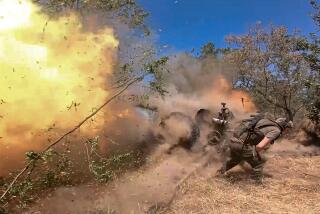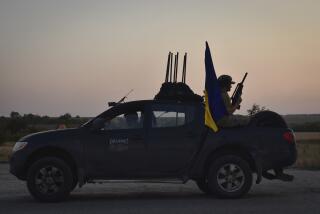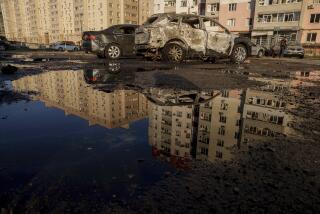Footage Shows Catastrophic Damage to Russian Subâs Interior
MOSCOW â Pipes bent like wire. Thick walls sheared away. Huge steel casings crumpled like discarded soda cans.
The first footage of the internal damage to the salvaged Russian nuclear submarine Kursk tells the story of a catastrophe last year when the vessel sank in the Barents Sea.
Heavy steel pipes and walls were torn from the subâs interior by the force of the second and larger of two explosions, leaving a hollow molten shell. Tangled debris fills about two-thirds of the craftâs forward section.
Russian investigators have recovered 20 bodies from the submarine in the past three days. Including the 12 recovered last year, that brings the number found to 32 of the 118 crew members who perished in the Aug. 12, 2000, disaster.
Seven of the bodies pulled from the hull in recent days have been identified, and six of them were to be flown to their families Saturday.
Meanwhile, Russian Prosecutor General Vladimir Ustinov, who heads the investigation of the Kursk tragedy, firmly answered the question that has haunted Russians: He said there was never a chance of rescuing any of the crew because the vessel was flooded within eight hours of the blasts.
âI would like to tell those who think that there was a possibility to save our submariners: I think there was no such possibility. There is evidence that the submarine was fully inundated with water in a matter of eight, seven, maximum eight hours, as our experts have been saying,â he said.
âAnd unfortunately, the rescue party was powerless to do anything according to all rescue standards.â
A seven-minute official film accompanied by Ustinovâs grim commentary aired repeatedly on Russian television Saturday evening, reopening the wounds of many grieving families.
âYou can see that everything here is cut off practically like with a knife,â said a somber Ustinov, gesturing at the areas where cables, pipes and walls were torn away. âFarther here is the place where the periscopes used to be--everything is cut off clean here.
âWhat happened inside these compartments was an inferno, an inferno as horrible as a person can conceive,â he went on.
Ustinov said most of the crew was in the forward areas where the force of the blasts was fiercest, including the captain and senior officers. It would be difficult to recover any human remains under the debris, he said, but the recovery crew will do its best.
At the end of his presentation, Ustinov uncovered his head and paid tribute to the dead.
The cause of the Kursk explosions, which occurred about two minutes apart during naval exercises, is still unknown.
Ustinov said the disaster may not be fully explained until the bow, where the blasts occurred, is raised from the ocean floor next year. That section was cut off before the Kursk was salvaged for fear it would tear off and destabilize the submarine while it was being raised.
âI will remind you that there were only 135 seconds between the first and the second explosions. That is why there was no opportunity to put rescue gear on,â Ustinov said. âNo one had the time to do it. Please understand that even if these outfits had been put on, no one could have survived what happened here. There was a huge explosion and a fire here.â
Russian President Vladimir V. Putin was bitterly criticized by angry families after the vessel sank for only belatedly cutting short a vacation as the crisis wore on.
In his effort to recover from the political damage, Putin promised families that the submarine would be raised and the bodies recovered.
Since the Kursk was hauled to dry dock in northern Russia 2 1/2 weeks ago, crews wearing breathing apparatus have been working day and night to recover the bodies.
Ustinov said the steel casings of the subâs two nuclear reactors and its missiles were strong enough to withstand the force of the explosions.
Russiaâs chief designer of nuclear reactors, Igor Serov, also insisted Saturday that the reactors are safe. The recovery crew, meanwhile, was drying the reactor compartment, where water was found. Radiation levels were normal, Serov said.
Russian experts plan to sever cables in order to prevent the reactors from activating. They will also weld shut all openings to the reactor section.
Ustinov said the sailors whose bodies were recovered died of suffocation, including the 23 who gathered in the rear section of the sub after the blasts.
A note found there last year on the body of Lt. Capt. Dmitry Kolesnikov described the conditions for the 23 men.
Experts outside Russia believe that the Kursk sank after one of its torpedoes exploded, triggering a second explosion of all the torpedoes. Russian authorities say a collision with another submarine or a World War II mine could be to blame.
On Saturday, the commander in chief of the Russian navy, Adm. Vladimir Kuroyedov, ruled out theories that a missile fired by the nuclear-powered cruiser the Pyotr Veliky (Peter the Great) during the military exercises might have been the catalyst.
âThe cause of the submarineâs fate is not connected with state secrets,â he said, adding that âeven if there are some state secrets there, the cause should be revealed. Otherwise, we will not find out what needs to be done to the navy today, and to create a navy for the future. The cause must be looked for, found and removed.â
More to Read
Sign up for Essential California
The most important California stories and recommendations in your inbox every morning.
You may occasionally receive promotional content from the Los Angeles Times.










